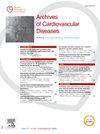Association between the left-to-right ventricular ratio and aortic regurgitation severity: An echocardiographic and cardiac magnetic resonance imaging study
IF 2.2
3区 医学
Q2 CARDIAC & CARDIOVASCULAR SYSTEMS
引用次数: 0
Abstract
Background
Left ventricular (LV) dilation in chronic significant aortic regurgitation (AR) is commonly assessed using LV diameters and volumes, but these metrics are influenced by body surface area, sex, and age. We hypothesized that the left-to-right ventricular end-diastolic volume ratio (LV/RV ratio), which remains close to 1 in healthy individuals, could provide a more individualized assessment of adverse LV remodeling in AR patients.
Objectives
We investigated the relationship between the LV/RV ratio, conventional LV metrics, and AR severity.
Methods
This bi-center study included 258 patients (median age: 55 years, 18% female) with at least chronic moderate AR, assessed using echocardiography (Echo) and cardiac magnetic resonance imaging (CMR). LV and RV volumes were measured from short-axis steady-state free precession cine-CMR images. The relationships between the LV/RV ratio, conventional LV metrics, and AR severity (Significant AR: grade 3-4 [Echo], Regurgitant fraction ≥ 33% [CMR]) were analyzed using area under the curve (AUC) and logistic regression models.
Results
The median LV/RV ratio was 1.54 [1.30; 1.88], with no significant difference by age or sex. A strong association was observed between the LV/RV ratio and significant AR, assessed by Echo (AUC 0.75, 95% CI [0.68–0.82]) and CMR (AUC 0.82, 95% CI [0.76–0.87]), remaining significant after adjustment for age and sex (Echo: OR 3.57, 95% CI [2.12–6.02], P < 0.001; CMR: OR 5.55, 95% CI [3.41–9.02], P < 0.001). The LV/RV ratio correlated more strongly with CMR AR-RegFrac (r = 0.66, P < 0.001) than conventional LV metrics and showed superior diagnostic performance, with a threshold of 1.5 identifying significant AR (Figure 1, Figure 2).
Conclusion
In chronic AR patients, the LV/RV ratio showed a stronger association with AR severity assessed by Echo and CMR than conventional LV metrics. These findings suggest its potential as an individualized marker for adverse LV remodeling in chronic AR, warranting further studies on its relationship with clinical outcomes.
左心室与右心室比值与主动脉瓣反流严重程度的关系:超声心动图和心脏磁共振成像研究
背景:慢性主动脉返流(AR)患者左室(LV)扩张通常通过左室直径和容积来评估,但这些指标受体表面积、性别和年龄的影响。我们假设健康人左、右心室舒张末期容积比(LV/RV ratio)仍然接近1,可以为AR患者不良左室重构提供更个性化的评估。目的:研究左室/右室比、常规左室指标与AR严重程度之间的关系。方法本双中心研究纳入258例至少患有慢性中度AR的患者(中位年龄:55岁,18%为女性),采用超声心动图(Echo)和心脏磁共振成像(CMR)进行评估。通过短轴稳态自由进动电影- cmr图像测量左心室和右心室体积。采用曲线下面积(AUC)和logistic回归模型分析LV/RV比、常规LV指标与AR严重程度(显著AR: 3-4级[Echo],返流分数≥33% [CMR])之间的关系。结果中位LV/RV比值为1.54 [1.30;[1.88],年龄、性别差异无统计学意义。通过Echo (AUC 0.75, 95% CI[0.68-0.82])和CMR (AUC 0.82, 95% CI[0.76-0.87])评估,观察到LV/RV比与显著AR之间存在强相关性,在调整年龄和性别后仍具有显著性(Echo: OR 3.57, 95% CI [2.12-6.02], P <;0.001;CMR: OR 5.55, 95% CI [3.41-9.02], P <;0.001)。LV/RV比值与CMR AR-RegFrac相关性更强(r = 0.66, P <;0.001),比传统的LV指标表现出更好的诊断性能,阈值为1.5识别显著的AR(图1,图2)。结论在慢性AR患者中,与传统的LV指标相比,Echo和CMR评估的LV/RV比值与AR严重程度的相关性更强。这些发现表明,它有可能作为慢性AR患者不良左室重构的个体化标志物,值得进一步研究其与临床结果的关系。
本文章由计算机程序翻译,如有差异,请以英文原文为准。
求助全文
约1分钟内获得全文
求助全文
来源期刊

Archives of Cardiovascular Diseases
医学-心血管系统
CiteScore
4.40
自引率
6.70%
发文量
87
审稿时长
34 days
期刊介绍:
The Journal publishes original peer-reviewed clinical and research articles, epidemiological studies, new methodological clinical approaches, review articles and editorials. Topics covered include coronary artery and valve diseases, interventional and pediatric cardiology, cardiovascular surgery, cardiomyopathy and heart failure, arrhythmias and stimulation, cardiovascular imaging, vascular medicine and hypertension, epidemiology and risk factors, and large multicenter studies. Archives of Cardiovascular Diseases also publishes abstracts of papers presented at the annual sessions of the Journées Européennes de la Société Française de Cardiologie and the guidelines edited by the French Society of Cardiology.
 求助内容:
求助内容: 应助结果提醒方式:
应助结果提醒方式:


